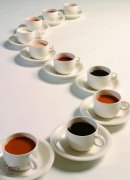What is the difference between espresso (Espresso) and individual coffee?
Today, a friend asked what is the difference between espresso (Espresso) and individual coffee. After thinking about it for a long time, it was quite tangled at that time. I always feel that the boundary between espresso and individual coffee seems to be getting less and less obvious. I also want to sort out my own ideas when I write this article today.
Let's first take a look at the concept of espresso and single coffee.
First, a brief introduction to the concept of espresso and single coffee.
Espresso: if you want to use the data for a general explanation, it means that 7g of powder is extracted by water at 92 degrees at nine atmospheres for 25,30 seconds to get 30ml coffee. The resulting 30ml coffee is called Espresso.
Single coffee: coffee made from only coffee beans from a certain country or a certain producing area, we call it single coffee.
Is the single coffee espresso?
Originally, it was thought that espresso must be made from blended coffee beans in order to be regarded as espresso, but in recent years, it has been found that the use of individual coffee beans to make espresso has gradually become a popular trend.
It breaks my previous idea. In fact, it can be seen from the above concept that the coffee produced by single coffee beans according to the production method of espresso is also espresso.
Is espresso a single coffee?
It says that single coffee can be espresso, so espresso is single coffee? The answer is: not necessarily, this needs to be verified from two aspects. That is, the types of coffee beans used. If the espresso is made from individual coffee beans (such as Brazil, Goran, Manning, etc.), Chen Lei thinks that this espresso can also be called single coffee.
Well, if the espresso is made with mixed coffee beans, then Chen Lei thinks that this espresso cannot be called a single coffee.
What is the essential difference between espresso and individual coffee?
From the above three aspects of comparison, we finally come to a conclusion: espresso can be a single coffee, or not a single coffee, the difference between this is based on the use of different coffee beans.
Single coffee can be either espresso or non-espresso, and the two are divided according to the concentration of the coffee liquid. For example, using a siphon pot to make Colombian coffee beans cannot be called espresso, while Colombian coffee beans made with a coffee machine can be called espresso.
Important Notice :
前街咖啡 FrontStreet Coffee has moved to new addredd:
FrontStreet Coffee Address: 315,Donghua East Road,GuangZhou
Tel:020 38364473
- Prev

Scientists analyze that a cup of black coffee contains more than a thousand ingredients
Scientists estimate that a cup of black coffee contains at least a thousand ingredients, and more than 850 compounds have been isolated from coffee in the laboratory.
- Next

Caffeine
What is caffeine? in fact, we are in contact with caffeine every day. The main source of caffeine in the food industry is coffee beans. But the caffeine content of coffee beans varies from breed to breed.
Related
- Beginners will see the "Coffee pull flower" guide!
- What is the difference between ice blog purified milk and ordinary milk coffee?
- Why is the Philippines the largest producer of crops in Liberia?
- For coffee extraction, should the fine powder be retained?
- How does extracted espresso fill pressed powder? How much strength does it take to press the powder?
- How to make jasmine cold extract coffee? Is the jasmine + latte good?
- Will this little toy really make the coffee taste better? How does Lily Drip affect coffee extraction?
- Will the action of slapping the filter cup also affect coffee extraction?
- What's the difference between powder-to-water ratio and powder-to-liquid ratio?
- What is the Ethiopian local species? What does it have to do with Heirloom native species?

